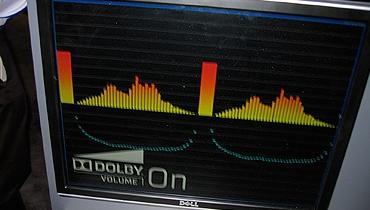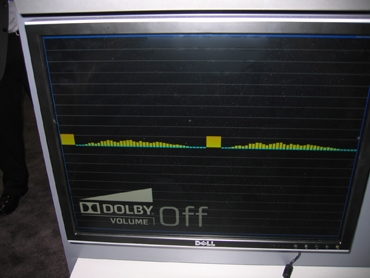Dolby to TV: Shut Up!

Really, there should be a law. Oh, sure, the F.C.C. has a regulation that TV commercials can't be louder than the programming surrounding them, but the advertisers skirt around that with some kind of compression trick. So ultimately, the commercials still sound . . . loud. And as for why so many TV stations come in at different sound levels . . . anyone?
So basically, when it comes to TV volume, it's like the wild, wild west out there. And Dolby Laboratories feels your pain (as in, the repetitive motion injury you get from constantly grabbing the remote to raise and lower TV volume). Thus, Dolby may have accomplished with technology what the government couldn't with a stern finger wagging: Evened out television sound. And we got a first-hand look at the process at work at CEDIA 2008.
First off, let's note an irony: Dolby's been playing both sides of the soundtrack fence. Not only has the big 'D' been working to even out TV volume, it's also been engineering the process that will give you the widest dynamic range ever on Blu-ray disc: Dolby TrueHD. This lossless audio codec offers everything from the softest whisper to the most berg-shaking rumble. (Wouldn't it be funny if the Dolby TrueHD guys had an office right next to the Dolby Volume guys? "Turn down that racquet!" the Volume guys would scream to the TrueHD guys).
So really, Dolby Volume is doing the opposite of Dolby TrueHD: compressing. It's compressing the audio of every show, matching the sound levels of the TV commercials to match the main program, matching all the channels you turn to so they sound similar to the one you're watching, and doing the same for all your inputs (so that your broadcast TV volume isn't blasting after you switch over from Blu-ray). And to get these results, you just choose a volume level that's comfortable for you. After that, the sonic levels for all programs and stations should be similar across the board.
 |
| Without Dolby Volume, a quiet TV channel shows little sonic activity. |
Word of Dolby Volume has been out for some months now, but at CEDIA 2008, we finally got to see it in action. The demo we saw involved a change of channels from some girly period piece movie (UPDATE: Our man John Sciacca ID'd the film as Jane Austin's Pride and Prejudice. Thanks John!) to an on-the-street news interview. With Dolby Volume turned OFF, the movie was quite quiet, and hard to hear, while the flip over to the news interview was loud and jarring. With DV turned ON, the levels evened out, with Pride apparently not so ashamed to speak up and the street interview less in-your-face. (You can hear a great online demo by clicking here.)
- Log in or register to post comments
























































